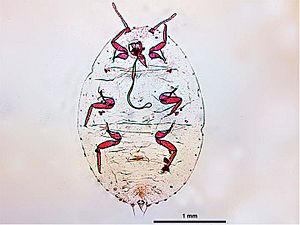Dysmicoccus brevipes facts for kids
Quick facts for kids Dysmicoccus brevipes |
|
|---|---|
 |
|
| Scientific classification | |
| Genus: |
Dysmicoccus
|
| Species: |
brevipes
|
A pineapple mealybug (scientific name: Dysmicoccus brevipes) is a tiny insect known as a mealybug. It got its scientific name from Theodore Dru Alison Cockerell in 1893. These small bugs mostly live on pineapple plants. But they can also be found on other plants like citrus trees, cotton, bananas, and coffee plants.
What Does the Pineapple Mealybug Look Like?
Adult pineapple mealybugs are usually pink or pink-orange. Their bodies can be round or oval. They are quite small, measuring about 2.3 to 3.0 millimeters long.
These insects have special glands that make wax. This wax forms short, waxy threads. These threads cover their bodies, helping to hide them. Young mealybugs, called larvae, are flat and have long hairs.
Life Cycle and Reproduction
Pineapple mealybugs have a unique way of having babies. The female mealybug gives birth to live young. This is called being ovoviviparous. It means the eggs hatch inside her body.
A female mealybug can have many babies, usually 200 to 300. After giving birth, the mother mealybug dies. The first stage of young mealybugs are called "crawlers." These tiny crawlers move around to find new plants. Sometimes, the wind helps them travel to new homes.
The young mealybugs grow through different stages. This growing period lasts about five weeks. They only eat during their first and early second stages. After changing their skin three times, they become adults. A pineapple mealybug usually lives for about 95 days in total.
Where Does the Pineapple Mealybug Live?
You can find Dysmicoccus brevipes in many different places around the world. They live in Hawaii and other Pacific islands. They are also found in Central and South America. You can see them in Australia and parts of Africa too.

